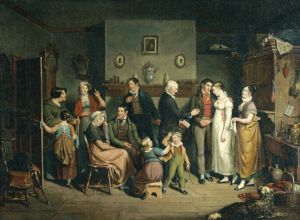Tales and Truths: Defining Artists of the Early Republic
Advance registration is required.
This is event is being held online. After registering, connection information will be emailed to you.

Online Lecture Series
In the earliest years of the democratic experiment, many now iconic artists contributed to the creation of a national identity, and their work reflects early ideas about government, immigration, capitalism, technology and our relationship to natural resources that are still influencing the politics of the present. Each week, Monica Zimmerman, PAFA's Vice President of Public Education, Engagement, and Museum Operations, will dive deeply into the stories of five artists who had the privilege of shaping our earliest ideas of art and citizenship and consider how we find ourselves wrestling with both the dreams and the prejudices that they helped to enshrine.
July 19 – Benjamin West
West’s career set the stage for American artists to find international visibility, defining ideas about the new country’s values on religion, education and aesthetics. But West’s works also codified mythologies around the original inhabitants of these lands that laid the groundwork for centuries of racism and oppression.
July 26 – Charles Willson Peale
Peale was a painter, scientist, soldier, tinkerer and politician. His long and varied career, from raising troops for the War of Independence to excavating the first mastodon skeleton for public audiences, illuminated early decisions about government policy, natural history, and civic engagement.
August 2 – John Lewis Krimmel
Krimmel’s paintings show the daily adventures of a burgeoning American citizenry, including weddings, holidays, and even election days. He was also the first artist to depict free slaves as part of American society, using distortions in physiognomies to identify his African American subjects.
August 9 – Thomas Birch
Birch’s landscapes, including his much reproduced image of Philadelphia’s engineering marvel, the Water Works, ushered in Philadelphia’s reputation as a modern city and made it possible for Americans to imagine healthy, clean American cities.
August 16 – Samuel F.B. Morse
Trained during the War of 1812, Morse’s paintings are often read as an allegory of debates around both religion and Federalism, informed by his outspoken anti-immigration beliefs. He also contributed to the invention of the telegraph and the game-changing technology that bears his name - Morse code.
Image: John Lewis Krimmel, Country Wedding, Bishop White Officiating, c. 1814, Oil on canvas, 16 3/16 x 22 1/8 in., Gift of Paul Beck, Jr.
We're so excited you're planning to visit PAFA!
Make time for art — visit us Thursday to Sunday.
Before reserving your tickets, please review helpful information about museum hours, accessibility, building access, and special admission programs.
If you have any questions, feel free to reach out to us at visitorservices@pafa.org — we’d love to help!